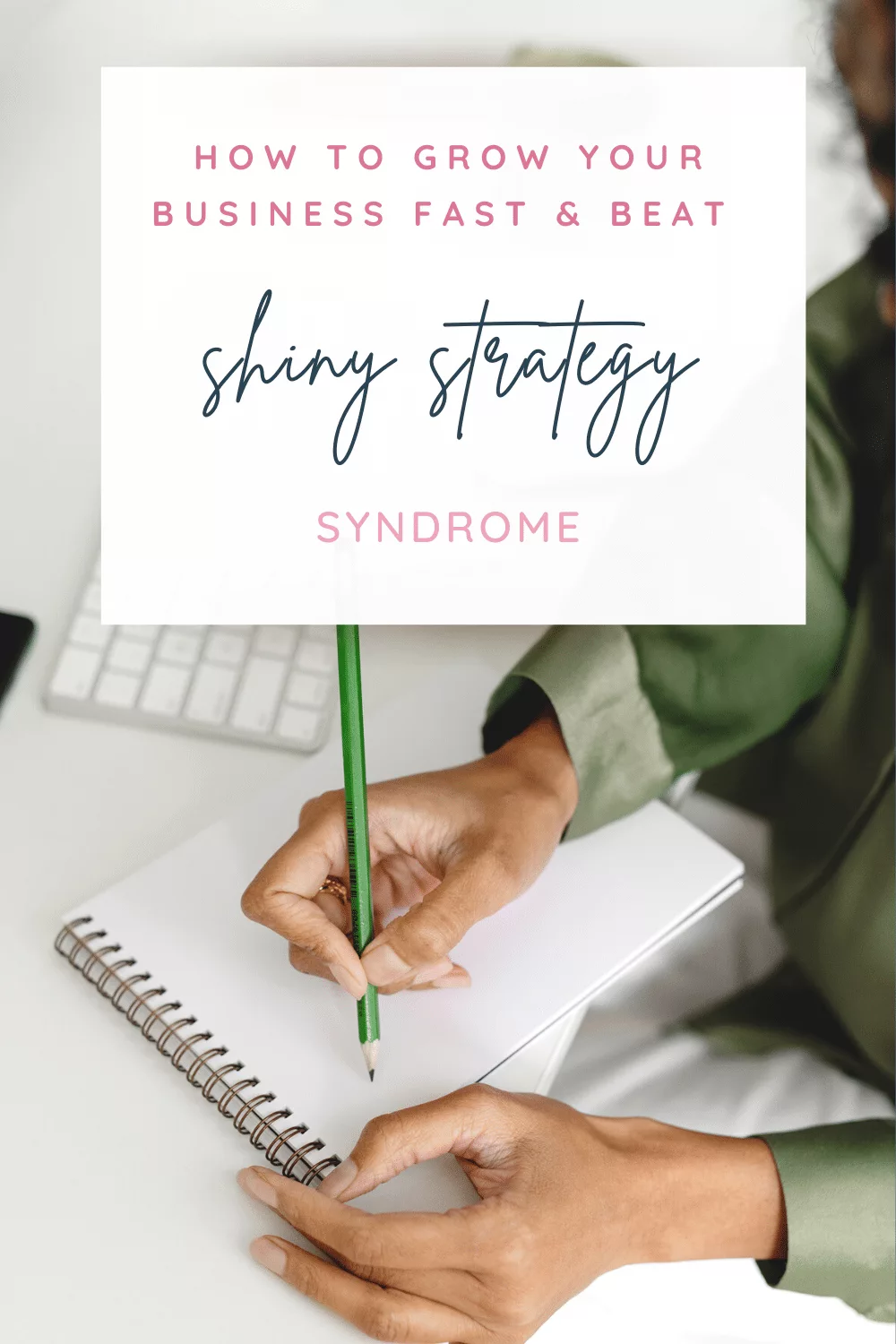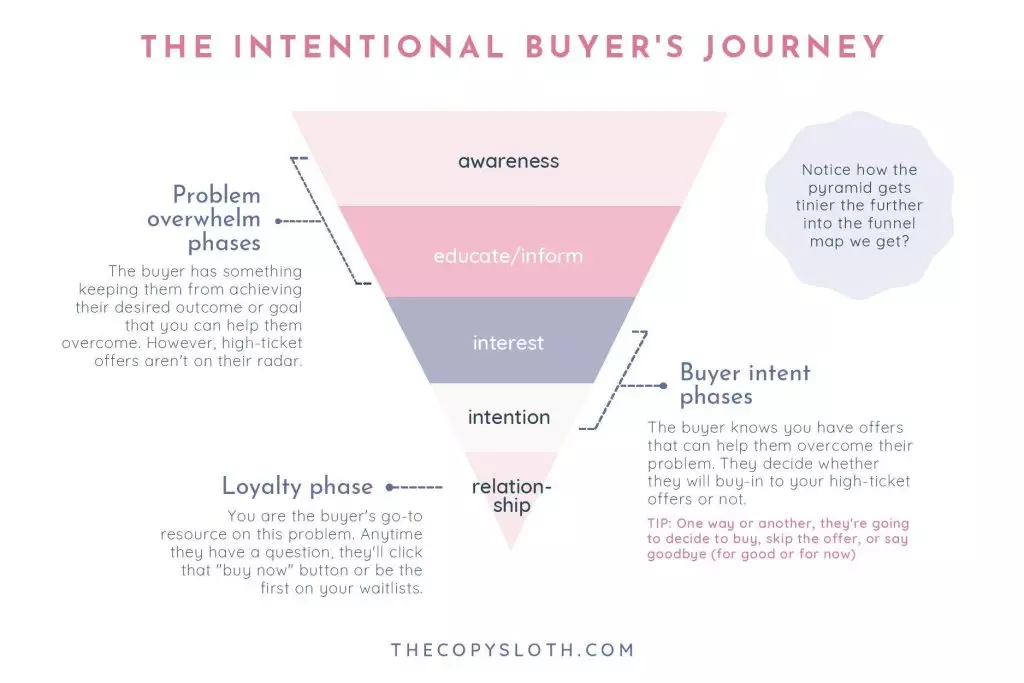This post may contain relevant affiliate links. These give me a small commission at no additional cost to you if you make purchases with them. Please see my disclaimers for more information.
One of the fastest ways to ensure that your business doesn’t ever actually grow is shiny strategy syndrome. Despite how it sounds, this is not another online buzzword. It’s a real problem that so many business owners deal with.

In most cases, it’s an invisible issue that lingers around in the background unless you know what to look for. Shiny strategy syndrome is the direct culprit behind your overwhelm that sets in when you try to implement too many strategies at once.
You never give your existing strategies room to succeed because you’re unable to dedicate enough time and focus on them. When you overburden yourself with too many tasks and goals, your productivity screeches to a halt. All that work piles up, and nothing actually gets done.
That’s why it’s important to make sure every strategy you use in your business has an intentional, strategic purpose or function. Otherwise, shiny strategy syndrome looms overhead, and you’re stuck without meaningful growth and nowhere closer to the results you need.
Most of the time, this pesky problem begins the more you listen to too many creators, thought leaders, and/or coaches. Any strategy can work for online business owners: you just need to give them the space and opportunity to breathe. Once you do, you can assess the results and tinker a little more with that before you completely decide to move on to something new.
In this post, you’ll learn how to combat shiny strategy syndrome and more about the only seven strategies you need as a business owner to skyrocket your growth online.
Table of Contents
Beat Shiny Strategy Syndrome
If you want to beat shiny strategy syndrome for good, you should have the right balance of strategies that work together to fully overcome this problem! Here are the only strategies you need to grow your business in 2022:
Offer ladder or sales funnel strategy
Whether you choose to call it your offer ladder, sales funnel, or client journey map, every business owner needs to know these two things:
- Your ideal client’s specific problems in the larger journey they take with your offers
- How each of your offers helps or serves these clients (and where they occur in this journey)
An offer ladder strategy walks your prospects and buyers through phases of a unique journey. In these phases, your offers, services, and/or products help them with ideally one specific problem (or a collection of related problems) at once.
Stuck on who your target customers or ideal clients are? Download my free buyer persona Canva template to help give you some clarity! Make it yours by branding it to your business’ standards in just a few minutes.
Strong sales funnel strategies will adapt to your ideal prospects and buyers’ knowledge and interest of both their core problem and the services or products you offer them to help them overcome it. That simply means that the things you offer them scale in simplicity and difficulty.
For example, the most popular offer at the awareness stage is typically called a lead magnet or freebie. Lead magnets are perfect for your high-level leads and prospects because they target one tiny problem and give your prospects a quick win or easy-to-achieve result.
Your offers scale in both price and result the deeper into your sales funnel the ideal buyers go!
Here’s a bit more on the three core phases of what I call the intentional buyer’s journey:

1. Problem overwhelm phases
The buyer has something keeping them from achieving their desired outcome or goal that you can help them overcome. However, high-ticket offers aren’t on their radar.
- Awareness
- Educate/inform
2. Buyer intent phases
The buyer knows you have offers that can help them overcome their problem. They decide whether they will buy-in to your high-ticket offers or not. TIP: One way or another, they’re going to decide to buy, skip the offer, or say goodbye (for good or for now)
- Interest
- Intention
3. Loyalty phase
You are the buyer’s go-to resource on this problem. Anytime they have a question, they’ll click that “buy now” button or be the first on your waitlists.
- Relationship
When you’re clear about your offer ladder, sales funnel, or client journey map, it’ll be that much harder for you to trip up on shiny strategy syndrome. You’ll know exactly who you’re speaking to, what they want and need your help with, and how to make your business grow in a way that’s sustainable for YOU.
Launching strategy
Whether you need to get the word out about your new product/service or want to spread the word about an existing offer, having a sustainable launching strategy will help you simplify the process, trim the loose ends, and keep your sanity intact!
The only things you need to create a profitable launching strategy include:
- Timeframe/schedule — You need to define how long you intend to be in “launch mode” and commit to it!
- Marketing plan — You have to know when and where to show up!
- Clear, consistent content — Whether it’s an email marketing campaign, social media content, or a paid ad campaign, you need to know how you will reach and speak to your leads, prospects, and buyers!
Launching doesn’t have to be hard. So if you’ve never created a launch plan or ran a launch campaign before, don’t think your strategy has to be overly complicated. I live and swear by simplicity and sustainability. The more protective of your energy and time you are, you’ll often attract more profit with less stress in my experience!
Building out your strategy only requires:
- Achievable, and realistic goals
- Familiarity of the market and clients you intend to help/serve
- General competition analysis
- A straightforward offer that provides an obvious result to your buyers
- How much time, energy, and resources you can commit to this launch
Marketing strategy
Think of your marketing strategy as the door or a window to your sales funnel. The more noise you make, the more attention your products or services will receive. Whether you opt for organic or paid marketing for your business, having a clear understanding of each of the following gives you the guidance you need to sustainably grow your business:
- Who you want to reach
- How you will speak to them
- What you need to do to convert leads and prospects into paying clients and customers
But it’s important to not confuse a marketing strategy with a marketing plan. They’re NOT the same thing! The simplest way I differentiate the two is by associating a marketing plan with the goals or specific objectives you want to achieve; whereas a marketing strategy is HOW you will carry out those goals or objectives.
So now with that in mind, I want to show you an easy way to approach creating a marketing strategy for your own business. You just have to remember that the purpose of this particular strategy is:
- Reaching new leads, prospects, and buyers for your offers
- Informing them of your value proposition
Your strategy shouldn’t match with someone else’s because a good marketing strategy targets the value YOU offer to YOUR ideal clients or customers and broadcasts it to these new people.
Social media strategy
Despite what you might think, you do not need to be present everywhere. Your ideal clients will not be on every single platform. That’s why you need to be strategic about where you show up!
This is where knowing your ideal client avatar comes in handy.
The general profile of your ideal clients will likely change as you grow. So I always emphasize progress over perfection. If you’re starting a new business, you’re only writing your chapter one (or maybe even just your prologue). Don’t shame and compare yourself to someone else’s chapter 25!
Accepting that you are only one person can be the difference between a profitable business owner who works strategically and someone who constantly feels overwhelmed and is stuck with that shiny strategy syndrome I mentioned earlier.
It’s true that not every business owner needs to be on social media, but organic marketing is free and accessible to anyone with an internet connection. At a minimum, honestly assess if you can afford to overlook social media for your business before you completely write it off.
Here’s what to consider when creating your own social media strategy:
- Know how much time you WANT to spend on social media
- Have a plan or workflow to help structure how you efficiently spend your time online
- Figure out how many posts you will publish each week
- Know where your ideal clients hang out social media
- Familiarize yourself with the more important features on the platforms you will use
Content strategy
Your content strategy is NOT the same thing as a content plan or even a social media strategy! There can be a ton of overlap; however, it’s important to give them their own unique attention when setting up your business’ strategies.
Content is more than just social media. It can include Facebook groups, email marketing, or even monthly memberships that you offer to your customers or clients. Every piece of content you publish (whether for free online or in your paid-for programs) should have a clear intention and role in your content strategy.
Keep in mind that content is often the first piece of your offer ladder or sales funnel that new leads, prospects, and buyers will see.
Here are a few things to think about when creating yours:
- Your target audience
- The purpose of the content (whether that is to inform, educate, or solve/tease a micro problem)
- The format of the content
- The frequency you’ll post
- What platform the content is for
- What action you want the audience to take
Video marketing strategy
Video content is the future of online marketing. Studies show that people can retain 95% of a video message as opposed to only 10% when they read text in a post. Buyers care about these two things more than anything else:
- Clear understanding about what’s being sold or shown
- Seller authenticity
Almost every single social media site has optimized its platform for video by now. In August 2020, Instagram introduced reels to its users. Users often report better reach and engagement rates when they post reels compared to regular static feed posts.
So exactly do you translate these facts into a cohesive video marketing strategy?
Not all video content is made equal. Your account and target audience will differ greatly—even within your own niche. It’s so important for you to understand how to test the content you post. You can do that by:
- Experimenting using different types of video content (e.g. videos with and without you in them)
- Testing out which times and days work best for your content
- Seeing if writing short or long captions earns more meaningful engagement
- Posting different video lengths
Lead generation strategy
Simply put, a lead generation strategy is a plan or method you implement to attract and encourage some kind of converting action from leads, prospects, and buyers to your business. Lead generation typically happens after someone sees or engages with your content, ad, message, and/or website.
Here are just some examples of lead generation strategies:
- Lead magnet/freebie swap for a lead’s email
- Referral or affiliate programs
- Workshops and webinars
- Job opp applications and discovery calls
- Run an ad campaign
- Launch a product or service
- Post or show up on social media
- Cold emailing or direct/private message outreach
This post is all about how to combat shiny strategy syndrome with the only seven strategies you need as a business owner to skyrocket your growth online.
Ready to get your copy + content to that *chef’s kiss* status — fast & easy?
Inspire your buyers with copywriting & content strategy services for intentional brands & wanna-be energetic masters.
I pack my posts and content with value and strategies I’ve used in my own business. But nothing quite beats working 1:1 with the copywriter to create custom copy that goes beyond a single conversion.






